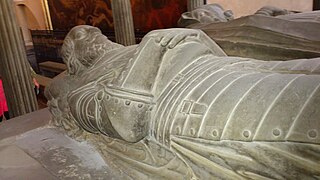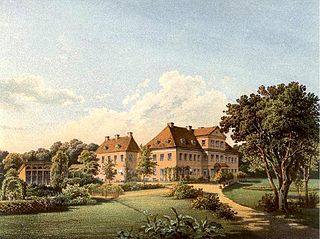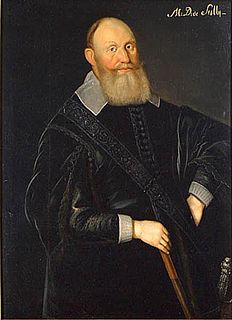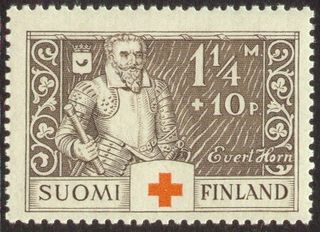 W
WCount Rutger von Ascheberg, also known as Roger von Ascheberg was a soldier, officer and civil servant in Swedish service, being appointed Lieutenant General in 1670, General in 1674, Field Marshal in 1678, Governor General of the Scanian provinces, in 1680, and Royal Councilor in 1681.
 W
WJohan Banér was a Swedish Field Marshal in the Thirty Years' War.
 W
WCount Nils Bielke was a member of the High Council of Sweden, military and politician.
 W
WJesper Mattson Cruus af Edeby (1576–1622) was a Swedish soldier and politician, being appointed Privy Councilor in 1612, Field Marshal in 1615, Lord High Treasurer in 1615, and Governor of Riga in 1621. In the Kalmar War (1611–1613) he led the Swedish troops to victory against the Danish forces, led by King Christian IV of Denmark, at the Battle of Kölleryd, on 21 February 1612. In 1622 he died in Riga after being wounded in a dispute with a local clergyman.
 W
WCount Erik Jönsson Dahlbergh was a Swedish military engineer, Governor-general and Field marshal. He rose to the level of nobility through his military competence. As an architect and draftsman, he was renowned for fortification works. He is most known for his collection of engravings Suecia Antiqua et Hodierna, a collection of engravings of topographical research.
 W
WAxel Julius de la Gardie (1637–1710) was a Swedish Field Marshal and was appointed Governor-General over Estonia.
 W
WField Marshal and Count Jacob Pontusson De la Gardie was a statesman and a soldier of the Swedish Empire, and a Marshal from 1620 onward.
 W
WCount and Burgrave Christopher Delphicus zu Dohna zu Carwinden was a German-born soldier and diplomat.
 W
WRobert Douglas, Count of Skenninge, Baron of Skalby, was a Scottish cavalry general during the Thirty Years' War rising to the rank of Field Marshal (1657–1662) in the Swedish-Polish wars that followed.
 W
WField marshal count Augustin Ehrensvärd was a Swedish military officer, military architect, artist, creator of the Suomenlinna (Sveaborg) fortress and the Swedish archipelago fleet. He was born in Fullerö Castle, Barkarö and died in the village of Saris, Mynämäki.
 W
WCount Hans Henric von Essen was a Swedish officer, courtier and statesman.
 W
WOtto Wilhelm von Fersen was a Swedish general and nobleman of the Fersen family, governor general of Ingmermanland and Kexholm from 1691 to 1698, field marshal 1693. He was the son of Hermann von Fersen the elder and cousin to Fabian von Fersen.
 W
WCount Fredrik Axel von Fersen was a Swedish statesman and soldier. He served as Lord Marshal of the Riksdag of the Estates, and although he worked closely with King Gustav III before and through the Revolution of 1772, he later opposed the king.
 W
WBaron Fabian von Fersen was a Swedish general, freelord, field-marshal and governor general of Skåne, Halland and Blekinge. He served the Swedish Empire in multiple wars and received appointments Field Marshal, and then Governor General of the Scanian lands, which included the provinces of Skåne, Halland and Blekinge in 1676.
 W
WBaron Simon Grundel-Helmfelt (1617–1677) was a Swedish field marshal and governor. Helmfelt is most notable for his overwhelming victory at the Battle of Lund despite being heavily outnumbered by Danish troops.
 W
WBaron Carl Carlsson Gyllenhielm was a Swedish soldier and politician. He was made a baron (friherre) in 1615, appointed Field Marshal in 1616, Privy Councilor in 1617, Governor General of Ingria in 1617 and served as Lord High Admiral from 1620 until his death.
 W
WJacob Johan Hastfer was a Swedish officer and governor of the Livonia province between 1687 and 1695.
 W
WFrederick William, Prince von Hessenstein, was a Swedish soldier and statesman. He was an extramarital son of King Frederick I of Sweden and his royal mistress Hedvig Taube.
 W
WEvert Karlsson Horn af Kanckas was a Swedish Field Marshall and Governor of Narva.
 W
WCount Gustav Horn af Björneborg was a Finnish nobleman of the Swedish Empire, military officer, and Governor-General. He was appointed member of the Royal Council in 1625, Field Marshal in 1628, Governor General of Livonia in 1652 and Lord High Constable since 1653. In the Thirty Years' War (1618–1648), he was instrumental as a commander in securing victory at the Battle of Breitenfeld, in 1631. He was High Councillor of the realm in 1625, elevated to the rank of field marshal in 1628, and sometimes commander-in-chief of Swedish forces in Germany during Thirty Years' War. After the war, he served as Governor-General of Livonia 1652, President of War department and Lord High Constable in 1653. In 1651, Queen Christina created him Count of Björneborg.
 W
WBaron Gustav Evertsson Horn of Marienburg was a Finnish-Swedish military and politician. He was a member of the Privy Council of Sweden and Governor General.
 W
WLars Kagg was a Swedish count and military officer. He was a political ally of King Gustavus Adolphus of Sweden, a member of the Privy Council of Sweden and Field Marshal during the Thirty Years' War.
 W
WCount Wilhelm Mauritz Klingspor was a Swedish noble military officer and one of the Lords of the Realm. He is probably best known from his time as field marshal of Finland during the Finnish War and for participating in the coup that dethroned Gustav IV of Sweden.
 W
WDodo Freiherr zu Innhausen und Knyphausen was a German professional soldier who saw extensive service in the Thirty Years' War (1618–1648), rising to the rank of Field Marshal in Swedish service in 1633.
 W
WCount Hans Christoff von Königsmarck, of Tjust, son of Conrad von Königsmarck and Beatrix von Blumenthal, was a Swedish-German soldier who commanded Sweden's legendary flying column, a force which played a key role in Gustavus Adolphus' strategy.
 W
WCount Otto Wilhelm Königsmarck was a Swedish military officer from Minden. He attained the rank of field marshal in 1676, commanded the Battle of Stralsund (1678), and became Governor General for Swedish Pomerania from 1679 to 1687. He was the son of Hans Christoff Königsmarck and the brother of Conrad Christoff Königsmarck. He was also the uncle of Aurora Königsmarck, Amalia Wilhelmina Königsmarck, Philip Christoph Königsmarck and Karl Johann von Königsmarck. Alongside Francesco Morosini, he led the Venetian conquest of the Morea in the early years of the Morean War, and died of the plague during the Siege of Negroponte (1688).
 W
WAlexander Leslie, 1st Earl of Leven was a Scottish soldier in Swedish and Scottish service. Born illegitimate and raised as a foster child, he subsequently advanced to the rank of a Swedish Field Marshal, and in Scotland became Lord General in command of the Army of the Covenanters, privy councillor, captain of Edinburgh Castle, Lord Balgonie and Earl of Leven. In England he commanded the Army of the Solemn League and Covenant and was senior commander of the Army of Both Kingdoms (1642–1647).
 W
WCount Gustaf Adolf Levenhaupt was a Swedish soldier and statesman.
 W
WCount Axel Lillie, also spelled Lillje was a Swedish soldier and politician. He was appointed Lieutenant Governor General of Pomerania in 1643, Privy Councilor in 1648, Governor General of Pomerania in 1652, Field Marshal in 1657, and Governor General of Livonia in 1661. In the Thirty Years' War (1618-1648), he commanded troops at the Battle of Leipzig, in 1642. He had Löfstad Castle built.
 W
WBaron Lorens von der Linde was a:Swedish Generalmajor since 1647 Swedish General since 1655 Swedish Field Marshal.
 W
WCount Johan August Meijerfeldt (1725-1800) was a Swedish field marshal. To distinguish him from his father, Johan August Meijerfeldt the Elder, he is generally referred to as Johan August Meijerfeldt the Younger.
 W
WCount Carl Gustav Rehnskiöld was a Swedish Field Marshal (Fältmarskalk) and Royal Councillor. He was mentor and chief military advisor to King Charles XII of Sweden, and served as deputy commander-in-chief of the Carolean Army, an army he assisted both in its education and development.
 W
WCount Johan August Sandels was a Swedish soldier and politician, being appointed Governor-general of Norway 1818 and Field Marshal in 1824. He also served as acting Over-Governor of Stockholm in 1815.
 W
WJohann Philipp Kratz von Scharffenstein was a German nobleman and field marshal, who fought during the course of the Thirty Years' War. He served with distinction in forces of both the Catholic League and Holy Roman Empire. His poor relationship with the Imperial generalissimo Albrecht von Wallenstein frustrated his plan of becoming the supreme commander of the League's forces. Embittered by this he defected to Sweden, where he attained the rank of field marshal. He was captured at the Battle of Nördlingen (1634) and executed for treason a year later.
 W
WGöran Silfverhielm was a Swedish Field Marshal.
 W
WCurt Bogislaus Ludvig Kristoffer von Stedingk was a count of the von Stedingk family, and a successful Swedish army officer and diplomat who played a prominent role in Swedish foreign policy for several decades.
 W
WCount Gustaf Otto Stenbock was a Swedish soldier and politician.
 W
WCount Magnus Stenbock was a Swedish field marshal (Fältmarskalk) and Royal Councillor. A renowned commander of the Carolean Army during the Great Northern War, he was a prominent member of the Stenbock family. He studied at Uppsala University and joined the Swedish Army during the Nine Years' War, where he participated in the Battle of Fleurus in 1690. After the battle, he was appointed lieutenant colonel, entered Holy Roman service as Adjutant General, and married Eva Magdalena Oxenstierna, daughter of statesman Bengt Gabrielsson Oxenstierna. Returning to Swedish service he received colonelcy of a regiment in Wismar, and later became colonel of the Kalmar and then Dalarna regiments.
 W
WCount Johan Christopher Toll, Swedish statesman and soldier, was born at Mölleröd in Scania. Toll came of an ancient family, of Dutch origin, which can be traced back to the 13th century, but migrated to the Baltic provinces in the 16th century.
 W
WLennart Torstensson, Count of Ortala, Baron of Virestad, was a Swedish Field Marshal and military engineer.
 W
WÅke Henriksson Tott (1598–1640) was a Finnish soldier and politician. His estates included Ekolsund in Sweden, Sjundeby in Finland, Polchow in Swedish Pomerania and Lihula in Swedish Livonia.
 W
WArvid Wittenberg or Arvid Wirtenberg von Debern, Swedish count, field marshal and privy councillor. Born in Porvoo, Finland, died in prison in Zamość, Poland, 7 September 1657. Arvid Wittenberg preferred call himself by the original Wittenberg family name, which was Wirtenberg von Debern.
 W
WFältmarskalk Carl Gustaf Wrangel was a Swedish statesman and military commander who commanded the Swedish forces in the Thirty Years', Torstenson, Bremen, Second Northern and Scanian Wars.
 W
WCarl Henrik Wrangel, friherre Wrangel af Adinal was an officer of the Swedish Army, attaining the rank of Field Marshal.
 W
WHerman Wrangel was a Swedish military officer and politician of Baltic German extraction.